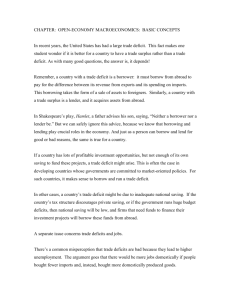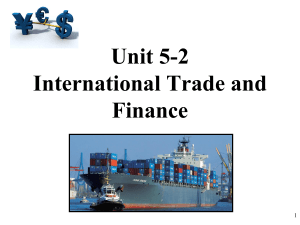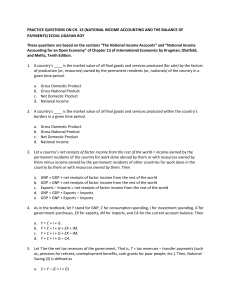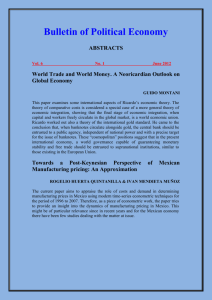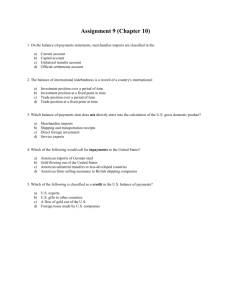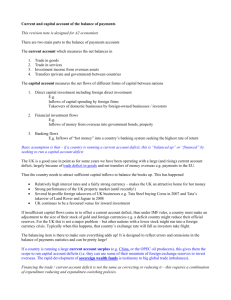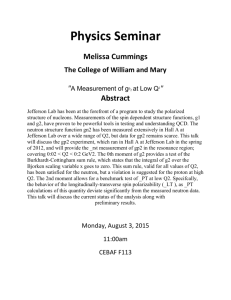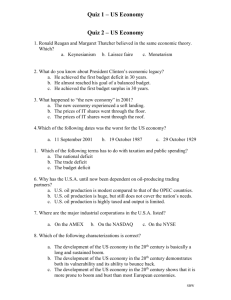Lecture on Chapter 12 – National Income
advertisement
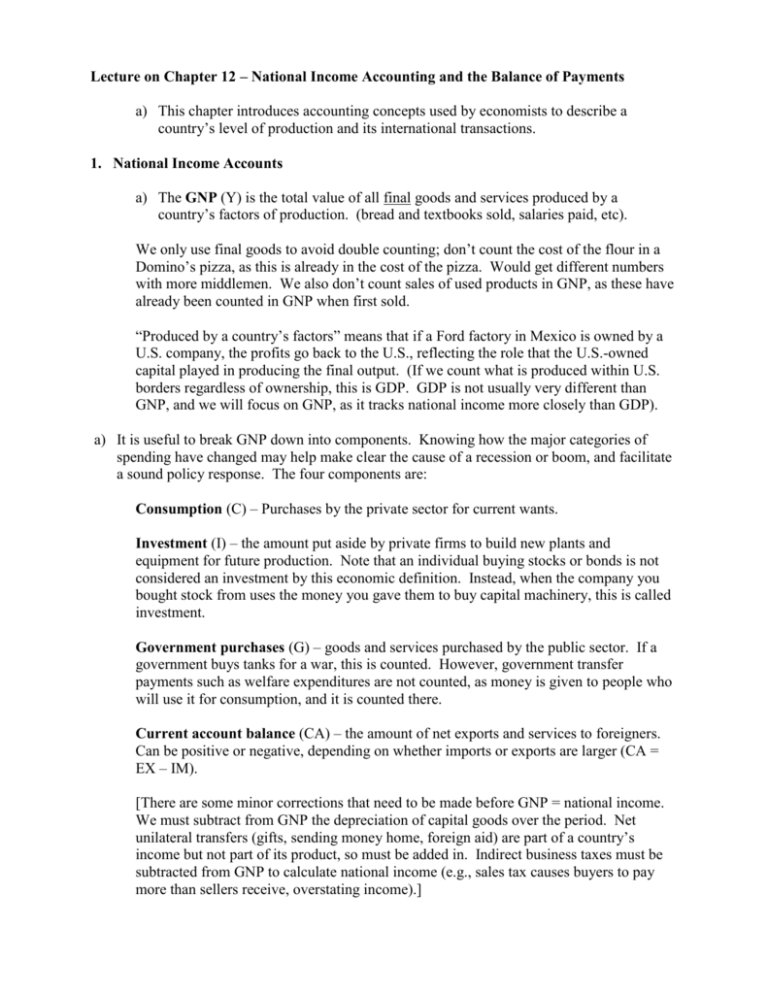
Lecture on Chapter 12 – National Income Accounting and the Balance of Payments a) This chapter introduces accounting concepts used by economists to describe a country’s level of production and its international transactions. 1. National Income Accounts a) The GNP (Y) is the total value of all final goods and services produced by a country’s factors of production. (bread and textbooks sold, salaries paid, etc). We only use final goods to avoid double counting; don’t count the cost of the flour in a Domino’s pizza, as this is already in the cost of the pizza. Would get different numbers with more middlemen. We also don’t count sales of used products in GNP, as these have already been counted in GNP when first sold. “Produced by a country’s factors” means that if a Ford factory in Mexico is owned by a U.S. company, the profits go back to the U.S., reflecting the role that the U.S.-owned capital played in producing the final output. (If we count what is produced within U.S. borders regardless of ownership, this is GDP. GDP is not usually very different than GNP, and we will focus on GNP, as it tracks national income more closely than GDP). a) It is useful to break GNP down into components. Knowing how the major categories of spending have changed may help make clear the cause of a recession or boom, and facilitate a sound policy response. The four components are: Consumption (C) – Purchases by the private sector for current wants. Investment (I) – the amount put aside by private firms to build new plants and equipment for future production. Note that an individual buying stocks or bonds is not considered an investment by this economic definition. Instead, when the company you bought stock from uses the money you gave them to buy capital machinery, this is called investment. Government purchases (G) – goods and services purchased by the public sector. If a government buys tanks for a war, this is counted. However, government transfer payments such as welfare expenditures are not counted, as money is given to people who will use it for consumption, and it is counted there. Current account balance (CA) – the amount of net exports and services to foreigners. Can be positive or negative, depending on whether imports or exports are larger (CA = EX – IM). [There are some minor corrections that need to be made before GNP = national income. We must subtract from GNP the depreciation of capital goods over the period. Net unilateral transfers (gifts, sending money home, foreign aid) are part of a country’s income but not part of its product, so must be added in. Indirect business taxes must be subtracted from GNP to calculate national income (e.g., sales tax causes buyers to pay more than sellers receive, overstating income).] 2. National Income Accounting In a closed economy, there are no imports or exports. Neglecting the above minor corrections, we have: Y=C+I+G The variables on the right have been defined to make this true; since this equation is true by definition, we call it an identity. The idea here is that in a closed economy, each item produced will be used for something within the country. It will be consumed by private households or by government, or it will be classified as investment, to either produce future output or to be inventory used for consumption next period. We can also rearrange terms to get: Y - C - G = I, or S = I, where S is total national saving. In a closed economy, total saving must equal investment. In an open economy, goods and services can flow across national borders, so the GNP identity for open economies shows how the national income a country earns is divided between sales to domestic residents and sales to foreign residents. The value of imports must be subtracted from total domestic spending, while the value of exports must be added to it. If Chrysler makes a car bought by a European, it is in our GNP, but it isn’t in C, I, or G. We need to list it separately. If your cousin buys a Toyota made in Japan, this will appear in U.S. consumption, but it isn’t part of our national product, so it must be subtracted out. This gives us: Y = C + I + G + EX – IM, or Y = C + I + G + CA A country with a current account surplus is earning more from its exports than it spends on imports. A country’s current account balance equals the change in its net foreign wealth. A country with a current account deficit ( surplus) is importing (exporting) present consumption and exporting (importing) future consumption. We can also express this as: Y – C – G – I = CA, or S – I = CA, so the current account is the difference between national saving and investment, or S = I + CA An open economy can save either by building up its capital stock or by acquiring foreign wealth, but a closed economy can only save by building up its capital stock. A country’s current account surplus is often referred to as its net foreign investment. Note the parallel between the net savings of an individual and the net savings of a country, as defined by the current account. A student might incur net dissavings to build up human capital, while a country might do so to build up its capital stock for the future. Alternatively, a student might simply consume student loans by taking vacations and partying down, and a country can essentially do the same. Thus, not all current account deficits are the same. Borrowing to improve one’s future may be very useful, while borrowing for pure consumption does not lead to tangible future benefits. Do example in book, pp. 306-7. Also point out pattern in Figure 12.2: a large decrease in U.S. foreign assets occurred after the early ‘80s and the U.S. accumulated a substantial foreign debt. 3. Private and Government Saving, Twin Deficits Government saving decisions may be made with an eye toward their effect on output and employment. How does this work? Private saving (Sp) is defined as the part of disposable income that is saved rather than consumed. Disposable income is Y – T (the taxes collected by the government from households and firms). Sp = Y – T – C and Sg = T – G S(national saving) = Y – C – G = (Y – T – C) + (T – G) = Sp + Sg = I + CA We can also write this as CA = Sp – I – (G-T), where (G-T) is the government budget deficit. Many people talk about government budget deficits and current account deficits as being twin deficits. The identity above shows that there is indeed a relationship between the two. All else equal (for I and Sp), a rise in the government deficit increases the current account deficit. However, this link is not direct, as there are other variables that have effects. Probable explanations for the large U.S. CA deficit (see case study, pp. 311-3) a) All three elements, Sp, I, and (G-T), play a role. b) However, in the mid ‘80s, the large sustained current account deficit seems mainly attributable to budget deficits. c) In the ‘90s and now, the large sustained current account deficit seems mainly due to low private saving as well as large investment expenditure. We are limited in how much we can definitely say about economic causes of CA deficit (which caused which) or whether it is economically justifiable. But with the tool of the national accounting equation, we see that there are links between the variables. To be more definite about causes and welfare implications, we need to build more theoretical tools. 4. Balance of Payments Accounting The balance of payments accounts are a detailed record of transactions with the rest of the world. Nations buy and sell goods, services, and assets of various types. The BOP accounts keep track of both payments to foreigners and receipts from foreigners. a) Accounting rules Rule 1: A transaction resulting in a payment to foreigners is as a debit and given a negative sign. Example: an American buys a Rolls Royce from UK, is a debit for U.S, negative sign. Any transaction resulting in a receipt from foreigners is entered as a credit and is given a positive sign. Example: British person buys a Chevy, is a credit for U.S., positive sign. Rule 2: We divide transactions into two types, either goods/services or assets. If these involve export or import of goods or services, they enter directly into the current account. A British person buying a Chevy is a credit in U.S. current account. However, if they involve the purchase or sale of assets, they enter into the capital account. An asset is any form of wealth, such as money, stocks, factories, government bonds, land, etc. If a British person buys stock in Chevrolet motor company, this is a credit in the U.S. capital account (asset, not the product) Rule 3: This is double-entry bookkeeping - Every international transaction automatically enters BOP twice: once as a credit and once as a debit. See examples on p. 315. Since every transaction gives rise to two offsetting entries in the balance of payments, a current account debit will necessarily be offset by a credit, either in the current account or in the capital account. So we know that if we add up CA and KA, we will get zero: Current Account + Capital Account = 0 Recall that the current account is how much more a country is spending than producing, or saving minus investment. If you are spending more than producing, you have a current account deficit, which you must somehow finance. You could sell assets in your country to pay for the goods you want. This would generate a capital account credit to balance the current account deficit. Or you could issue debt to sell to foreigners, another way of borrowing, and this would also be a capital account credit. We can refer to this as a “capital inflow” to finance the current account deficit. b) Current account (see Table 12-2, p. 316) Now we give more detail about how to compute each account. Three categories: 1.Exports - credit 2.Imports - debit 3.Transfers Exports and imports are each divided into three categories: 1.merchandise: goods, like Chevys and Rolls Royces 2.services: legal assistance, shipping fees, tourism 3.investment income: interest and dividend payments and earnings of domestically-owned firms operating abroad. There is one additional category in CA- net unilateral transfers. The $166.4 billion deficit in the current account (Table 12-2) must be offset in the capital account. c) Capital account Recall that this measures the change in net holdings of foreign assets. This breaks down into: 1) the change in U.S. ownership of assets located abroad (an increase is a debit, a capital outflow), and 2) the change in foreign ownership of assets located in the U.S. (an increase is a credit, a capital inflow). Guess what? The books don’t balance, as there is a substantial statistical discrepancy. There are undoubtedly errors in recording complex financial trades between countries (in the capital account) and data on services is also suspect (in the current account). Not only that, but the world’s books don’t balance either (see box on pp. 319-20) We also have official reserve transactions, a capital account entry involving the purchase or sale of official reserve assets by central banks. Central banks hold foreign assets; they buy and sell them as a way to influence the financial markets. The “official settlements balance” is the sum of the Current account, the statistical discrepancy, and the part of the capital account excluding the official reserve transactions. It thus indicates how much of a gap was left in the balance of payments after private transactions were made, and how much the central banks intervened to fill in this gap. In 1994 the capital account was in surplus $188.9 billion. This means that U.S. net wealth fell by $188.9 billion. This helped finance the current account deficit- it’s a capital inflow. d) Case study: The U.S. as the world’s biggest debtor Because the current account equals the change in net foreign assets in a year, each year that the current account is in deficit, the net foreign assets position of the U.S. falls. Because of the years of current account deficits, the U.S. has gone from the world’s largest net foreign creditor to the largest foreign debtor. But while the number is large, it remains small relative to our GDP (12% compared to 37% for other Western Hemisphere debtors).


